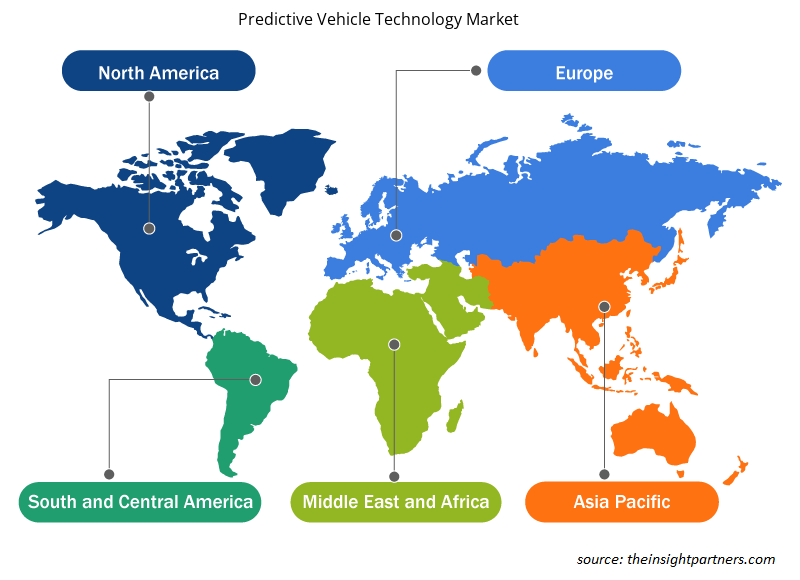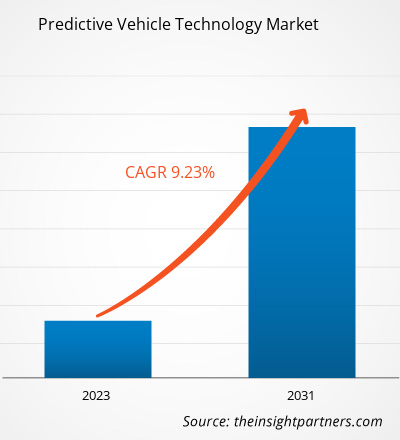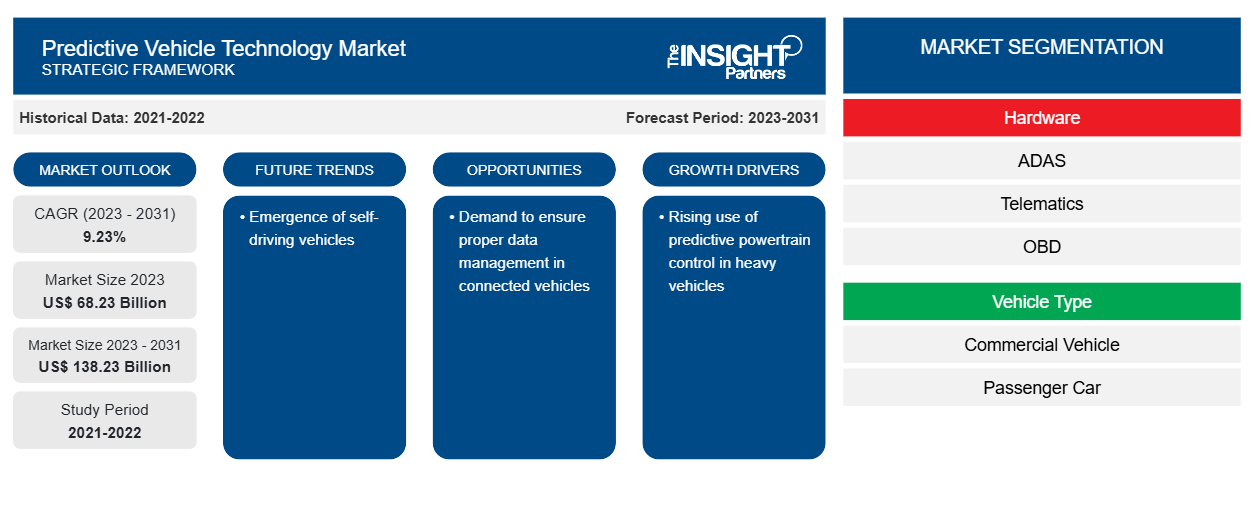Le marché des technologies prédictives pour véhicules devrait atteindre 138,23 milliards USD d'ici 2031, contre 68,23 milliards USD en 2023. Le marché devrait enregistrer un TCAC de 9,23 % en 2023-2031. Les avantages du PPC ont incité les constructeurs automobiles, en particulier les constructeurs de véhicules utilitaires lourds, à intégrer le PPC dans leurs véhicules. Le PPC peut être installé ultérieurement dans presque tous les types de camions et de véhicules lourds.
Analyse du marché des technologies prédictives pour véhicules
Les principaux acteurs de l'écosystème mondial du marché de la technologie prédictive des véhicules comprennent les fournisseurs de technologie, les fournisseurs de composants, les OEM et un segment d'utilisateurs finaux de l'industrie automobile. Les fournisseurs de technologie proposent des technologies d'IA, d'apprentissage automatique et prédictives aux constructeurs automobiles pour intégrer cette technologie dans des systèmes tels que ADAS , OBD, télématique, V2X, etc. Les fabricants de composants de ce système mentionné incluent des capteurs, des caméras, des écrans, etc. Plus tard, le produit système intégré à la technologie est installé dans le véhicule pour offrir une expérience sans tracas à l'utilisateur en garantissant la sécurité du conducteur et du passager. Un canal de distribution composé d'équipementiers fournit le produit final fini à la catégorie des utilisateurs finaux. Les voitures particulières et les véhicules utilitaires utilisent la technologie prédictive et les produits finis intégrés dans leurs véhicules. La technologie automobile prédictive trouve son application dans tous les types de véhicules, y compris les voitures, les fourgonnettes, les SUV et les camions.
Aperçu du marché des technologies prédictives pour véhicules
À l’heure actuelle, l’industrie automobile connaît une intégration importante de diverses technologies avancées dans les voitures pour améliorer la sécurité et l’efficacité des occupants. Les constructeurs automobiles exploitent l’intelligence artificielle (IA) et l’apprentissage automatique (ML) pour comprendre les modèles et les tendances du conducteur et améliorer la sécurité du véhicule. Ces deux technologies sont prêtes à devenir un élément essentiel des véhicules à venir et de l’ industrie automobile . Dans la course aux voitures connectées et aux véhicules autonomes, les technologies de véhicules prédictifs sont de plus en plus acceptées par tous les types de véhicules, ce qui offre un confort notable au conducteur et aux passagers. Par conséquent, les constructeurs automobiles se concentrent sur l’adoption de gadgets connectés et de l’IoT dans les véhicules prenant en charge les commandes vocales. L’intégration de l’IoT dans les voitures connectées est le prochain grand développement numérique qui persiste dans l’industrie automobile. Ce fait entraînera une autre révolution via l’introduction de véhicules autonomes. Les voitures autonomes/véhicules autonomes comprennent un système de gestion des capteurs qui rend la communication IoT de véhicule à véhicule possible et une réalité. Les facteurs susmentionnés des voitures connectées devraient contribuer à l’utilisation de la technologie prédictive en introduisant un système prédictif d’évitement des collisions, un système de maintenance prédictive, etc.
Personnalisez ce rapport en fonction de vos besoins
Vous bénéficierez d'une personnalisation gratuite de n'importe quel rapport, y compris de certaines parties de ce rapport, d'une analyse au niveau des pays, d'un pack de données Excel, ainsi que d'offres et de remises exceptionnelles pour les start-ups et les universités.
-
Obtenez les principales tendances clés du marché de ce rapport.Cet échantillon GRATUIT comprendra une analyse de données, allant des tendances du marché aux estimations et prévisions.
Moteurs et opportunités du marché de la technologie prédictive pour les véhicules
Utilisation croissante du contrôle prédictif du groupe motopropulseur dans les véhicules lourds
Le contrôle prédictif du groupe motopropulseur (PPC) est apparu il y a quelques années et a pris de l'ampleur à l'heure actuelle. L'adoption du PPC permet de réduire la consommation de carburant jusqu'à 5 % dans le trafic longue distance. Il s'agit d'un système de régulateur de vitesse distinct qui permet d'économiser des ressources monétaires grâce à des prévisions intelligentes. Le PPC utilise des cartes 3D et des données GPS pour scanner une route devant soi. Plus tard, le système ajuste automatiquement la vitesse en fonction du roulage. Les améliorations apportées à la modernisation du PPC sont bien adaptées aux services télématiques FleetBoard, car ceux-ci sont déjà utilisés dans les camions. Les fabricants de poids lourds se rapprochent d'unités commerciales complémentaires pour améliorer leur portefeuille de produits et acquérir une expertise supplémentaire dans les tendances du PPC. Par exemple, la technologie PPC de Mercedes-Benz est disponible pour la modernisation des Actros, Arcos et Antos par les partenaires Mercedes-Benz dans toute l'Europe. Le PPC de Mercedes-Benz a commandé en moyenne 64 % des véhicules lourds pour les trajets longue distance. La demande croissante de véhicules utilitaires lourds devrait accroître l'adoption de la technologie prédictive dans les véhicules lourds.
Demande de garantir une gestion adéquate des données dans les véhicules connectés
L'opportunité la plus répandue dans le domaine des voitures connectées est la gestion des données. Les voitures connectées diffusent d'énormes quantités de données dans le cloud et, par conséquent, pour utiliser d'énormes données, le besoin d'analyse prédictive et d'analyse des données augmente. L'évitement prédictif des collisions, la maintenance prédictive, le marketing automobile, le marketing automobile et la gestion des données des véhicules connectés sont quelques-uns des concepts croissants responsables de la croissance du marché. Une autre caractéristique est de stimuler l'utilisation de la technologie prédictive dans les véhicules. Nissan a développé un système d'évitement prédictif des collisions à l'aide de big data, de capteurs avancés et d'une connectivité véhicule à véhicule. Ce système nous permet d'évaluer la distance et la vitesse du véhicule devant une voiture et des deux véhicules qui la précèdent. De plus, une vidéo et un signal sonore seront envoyés au conducteur en cas de comportement inhabituel. Par conséquent, avec l'énorme avantage d'un système d'évitement prédictif des collisions, l'industrie automobile pourrait assister à un système d'évitement des collisions sophistiqué et efficace basé sur le comportement prédictif du conducteur, car les développeurs travaillent à l'avance pour créer des applications pour améliorer la communication entre les véhicules connectés.
Analyse de segmentation du rapport sur le marché de la technologie prédictive des véhicules
Les segments clés qui ont contribué à l’élaboration de l’analyse du marché de la technologie prédictive des véhicules sont le matériel, le type de véhicule et l’application.
- En fonction du matériel, le marché a été divisé en ADAS, télématique, OBD. Le segment des voiturettes de golf détenait une part de marché plus importante en 2023.
- En fonction du type de véhicule, le marché de la technologie prédictive des véhicules est segmenté en véhicules utilitaires et voitures particulières. Le segment des voitures particulières détenait la plus grande part du marché en 2023.
- En fonction des applications, le marché des technologies prédictives pour véhicules est segmenté en alertes proactives, sécurité et sûreté. Le segment de la sécurité et de la sûreté détenait la plus grande part du marché en 2023.
Analyse du marché des technologies prédictives pour véhicules par zone géographique
La portée géographique du rapport sur le marché de la technologie prédictive des véhicules est principalement divisée en cinq régions : Amérique du Nord, Europe, Asie-Pacifique, Moyen-Orient et Afrique et Amérique du Sud.
Les États-Unis, le Canada et le Mexique sont les principales économies d'Amérique du Nord. En raison des avancées technologiques, la région nord-américaine est restée un marché compétitif, car la population croissante a attiré plusieurs développements technologiques en raison de pouvoirs d'achat élevés. Au fil des ans, les véhicules sont devenus de plus en plus comme des ordinateurs sur roues, ce qui signifie que les techniciens d'atelier modernes ne peuvent faire leur travail qu'avec un outil d'analyse prédictive professionnel. La maintenance prédictive permet au constructeur automobile de réparer les éléments de n'importe quelle pièce automobile avant qu'elle ne se casse. L'utilisation de la maintenance prédictive permet aux fabricants de modifier le processus de fabrication et de se débarrasser du problème pour les futurs produits. La région étant très avancée en termes de technologie, diverses entreprises intègrent des outils de maintenance prédictive dans leurs véhicules de tourisme et commerciaux.
Informations régionales sur le marché de la technologie prédictive des véhicules
Les tendances et facteurs régionaux influençant le marché de la technologie prédictive des véhicules tout au long de la période de prévision ont été expliqués en détail par les analystes d’Insight Partners. Cette section traite également des segments et de la géographie du marché de la technologie prédictive des véhicules en Amérique du Nord, en Europe, en Asie-Pacifique, au Moyen-Orient et en Afrique, ainsi qu’en Amérique du Sud et en Amérique centrale.

- Obtenez les données régionales spécifiques au marché de la technologie prédictive des véhicules
Portée du rapport sur le marché de la technologie prédictive des véhicules
| Attribut de rapport | Détails |
|---|---|
| Taille du marché en 2023 | 68,23 milliards de dollars américains |
| Taille du marché d'ici 2031 | 138,23 milliards de dollars américains |
| Taux de croissance annuel composé mondial (2023-2031) | 9,23% |
| Données historiques | 2021-2022 |
| Période de prévision | 2023-2031 |
| Segments couverts |
Par matériel
|
| Régions et pays couverts |
Amérique du Nord
|
| Leaders du marché et profils d'entreprises clés |
|
Densité des acteurs du marché de la technologie prédictive pour véhicules : comprendre son impact sur la dynamique commerciale
Le marché des technologies prédictives pour véhicules connaît une croissance rapide, tirée par la demande croissante des utilisateurs finaux en raison de facteurs tels que l'évolution des préférences des consommateurs, les avancées technologiques et une plus grande sensibilisation aux avantages du produit. À mesure que la demande augmente, les entreprises élargissent leurs offres, innovent pour répondre aux besoins des consommateurs et capitalisent sur les tendances émergentes, ce qui alimente davantage la croissance du marché.
La densité des acteurs du marché fait référence à la répartition des entreprises ou des sociétés opérant sur un marché ou un secteur particulier. Elle indique le nombre de concurrents (acteurs du marché) présents sur un marché donné par rapport à sa taille ou à sa valeur marchande totale.
Les principales entreprises opérant sur le marché de la technologie prédictive des véhicules sont :
- Société AISIN SEIKI
- Ltd.
- Automate programmable Aptiv
- Traffilog SARL
- Continental AG
Avis de non-responsabilité : les sociétés répertoriées ci-dessus ne sont pas classées dans un ordre particulier.

- Obtenez un aperçu des principaux acteurs du marché de la technologie prédictive des véhicules
Actualités et développements récents du marché de la technologie prédictive des véhicules
Le marché de la technologie prédictive des véhicules est évalué en collectant des données qualitatives et quantitatives après des recherches primaires et secondaires, qui comprennent d'importantes publications d'entreprise, des données d'association et des bases de données. Voici une liste des développements sur le marché de la technologie prédictive des véhicules et des stratégies :
- En novembre 2023, la ville de La Nouvelle-Orléans a annoncé qu'elle utiliserait la technologie de Samsara Inc., le pionnier du Connected Operations™ Cloud, pour améliorer la sécurité, l'efficacité et la durabilité des opérations de la flotte de la ville dans 41 services, dont le service de police de la Nouvelle-Orléans (NOPD), le service d'incendie de la Nouvelle-Orléans (NOFD), le service des travaux publics (DPW), la division de l'application du code, le service des parcs et des promenades (PPW), le service de l'assainissement et bien d'autres. La ville investit 75 millions de dollars dans sa flotte et considère le partenariat technologique avec Samsara comme essentiel pour l'entretien et la protection de ses véhicules. (Source : Samara Inc, communiqué de presse/site Web de l'entreprise/bulletin d'information)
- En septembre 2023, M Group Services Plant & Fleet Solutions (MGSPFS) — la division de gestion de flotte du principal fournisseur de services d'infrastructures essentielles M Group Services — a travaillé avec Samsara, le pionnier du Connected Operations™ Cloud, et le fournisseur britannique de solutions de sécurité de flotte Motormax pour fournir la prochaine génération de systèmes de sécurité embarqués pour protéger les conducteurs, les usagers de la route et les citoyens. (Source : M Group Services Plant & Fleet Solutions, communiqué de presse/site Web de l'entreprise/bulletin d'information)
Couverture et livrables
Le rapport « Taille et prévisions du marché des technologies prédictives pour les véhicules (2021-2031) » fournit une analyse détaillée du marché couvrant les domaines ci-dessous :
- Taille du marché et prévisions aux niveaux mondial, régional et national pour tous les segments de marché clés couverts par le périmètre
- Dynamique du marché, comme les facteurs moteurs, les contraintes et les opportunités clés
- Principales tendances futures
- Analyse détaillée des cinq forces de Porter
- Analyse du marché mondial et régional couvrant les principales tendances du marché, les principaux acteurs, les réglementations et les développements récents du marché
- Analyse du paysage industriel et de la concurrence couvrant la concentration du marché, l'analyse de la carte thermique, les principaux acteurs et les développements récents
- Profils d'entreprise détaillés avec analyse SWOT
- Analyse historique (2 ans), année de base, prévision (7 ans) avec TCAC
- Analyse PEST et SWOT
- Taille du marché Valeur / Volume - Mondial, Régional, Pays
- Industrie et paysage concurrentiel
- Ensemble de données Excel
Rapports récents
Rapports connexes
Témoignages
Raison d'acheter
- Prise de décision éclairée
- Compréhension de la dynamique du marché
- Analyse concurrentielle
- Connaissances clients
- Prévisions de marché
- Atténuation des risques
- Planification stratégique
- Justification des investissements
- Identification des marchés émergents
- Amélioration des stratégies marketing
- Amélioration de l'efficacité opérationnelle
- Alignement sur les tendances réglementaires























 Obtenez un échantillon gratuit pour - Marché des technologies prédictives pour véhicules
Obtenez un échantillon gratuit pour - Marché des technologies prédictives pour véhicules